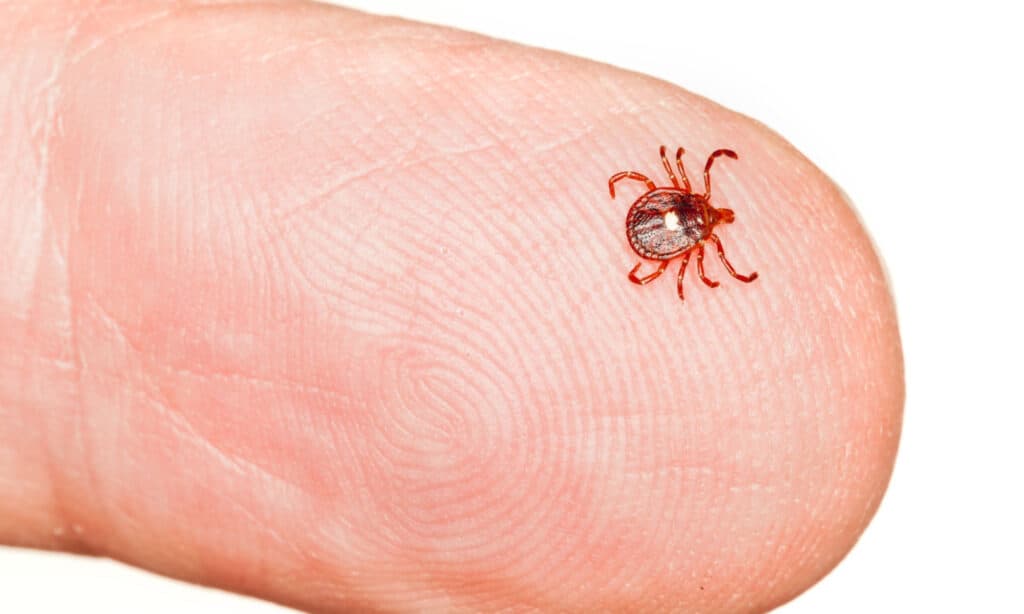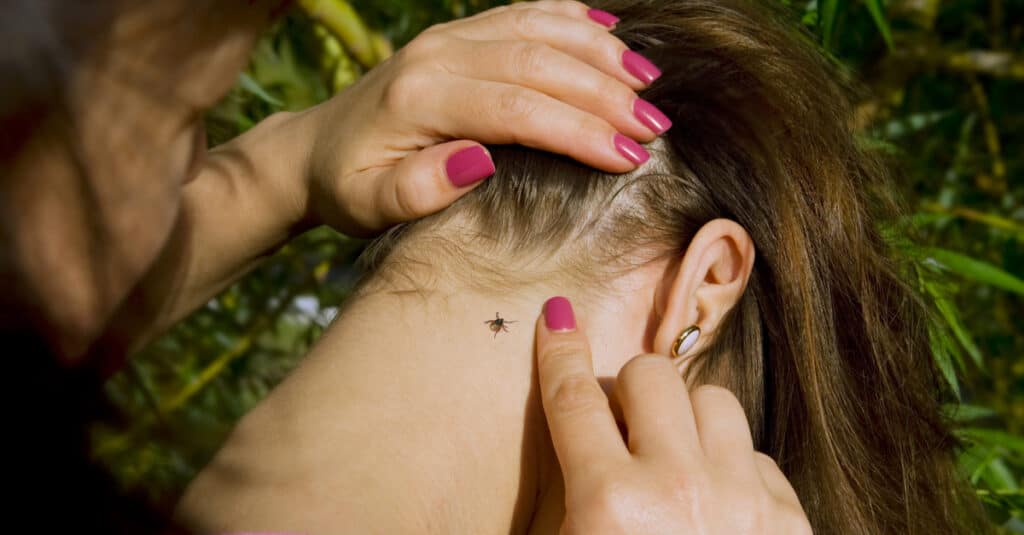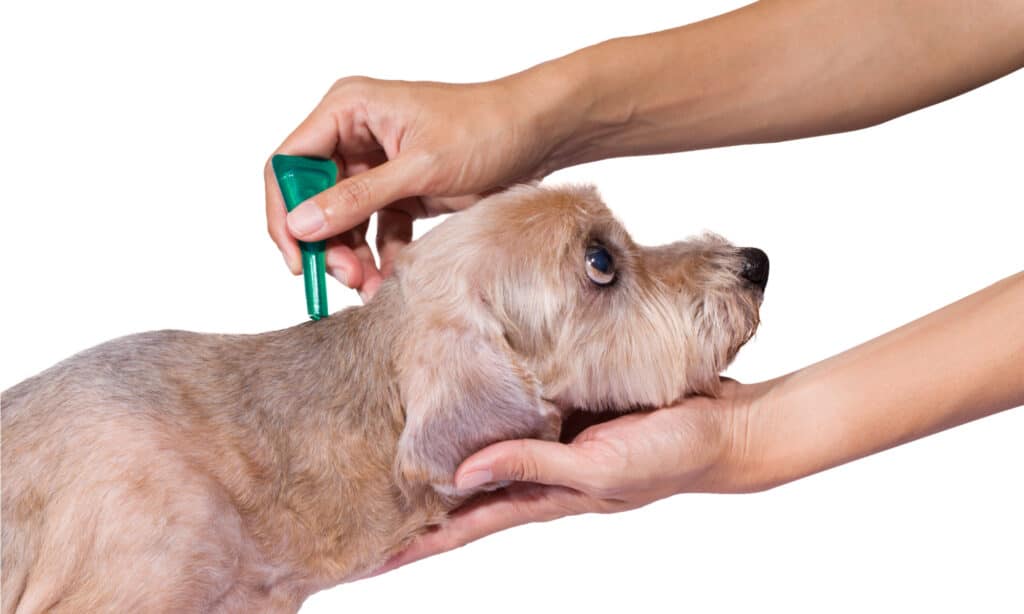There are nine hundred known species of ticks worldwide, and honestly keeping track of all of them is a challenge. But between the late spring and early summer, ticks become a real problem because we are spending more and more time in the outdoors.
More than that, our pets also are spending additional hours outside and come into contact with ticks in their environment. During this period commonly referred to as tick season, the topic of seed ticks comes up. But what are seed ticks, and how do we deal with them?
Let us find out!
What Are Seed Ticks?

Seed ticks are the second stage of a tick’s life cycle.
©Steve Heap/Shutterstock.com
Seed tick is the common term used for the second stage of the tick life cycle. Ticks have four total life cycles, egg, larval, nymph, and adult. Seed ticks are in the larval stage and are often hard to detect visually.
This is because larval ticks are exceedingly small, and not easy to see unless multiple larvae are present. This small size is what gave the seed tick its common name. Ticks still in this larval stage also lack the front legs, making this arachnid look more insect-like.
In temperate locations, ticks enter the larval stage in the early summer months and begin to seek out their first host. Like adult ticks, seed ticks prefer warm, moist, and overgrown areas and select prey based on body heat and location.
Many larval ticks die before reaching the nymph stage due to failure to find a host or being consumed by larger predators.
How Do You Know if You Have Seed Ticks?
Seed ticks are tiny, they can burrow into the skin and are difficult to detect. Usually, unless someone is diligently and regularly inspecting their body for seed ticks, these parasites may go unnoticed until they’ve already embedded themselves into the skin, resulting in a rash or other signs of skin irritation.
Tick larvae are often known as “seed ticks.” They emerge from the eggs laid by adult female ticks and are extremely small, making them challenging to spot individually. Their diminutive size means they are typically inconspicuous unless they are clustered together.
Seed ticks bear a resemblance to poppy seeds and have six legs.
Are Seed Ticks Dangerous?

Seed ticks have the potential to spread harmful illnesses and infections.
©Kalcutta/Shutterstock.com
Ticks in every stage of the life cycle from nymph onward must find a host and a blood meal to survive. The tick life cycle can last from 2-to 4 years depending on the species, but larva, nymphs, and adult ticks can carry disease.
While seed ticks often seek smaller mammals, reptiles, or other animals as a host, they can find their way to larger prey.
Can Seed Ticks Spread Diseases?
As for the potential of spreading the deadly disease, the seed tick is slightly less dangerous than a nymph or adult. Seed ticks have less likelihood of spreading disease host to host as this is the first cycle. However, since seed ticks are significantly smaller than adult ticks, they are much harder to see.
While a larval tick is far less likely to carry diseases like Lyme or Rocky Mountain Spotted fever, other infections are still a threat. In short, every tick is potentially dangerous, regardless of life stage!
How To Deal With Seed Ticks
Removing seed ticks can be trickier than removing an adult due to their small size. However, all ticks should be manually removed.
While many methods for removing a tick have been around for hundreds of years, very few work. Smothering a tick or attempting to get one to detach using chemicals like vinegar, alcohol, or essential oils simply do not work.
Additionally, more dangerous chemicals like gasoline, bleach, or even flame are not just ineffective, but dangerous. Remember, these chemicals and methods may or may not kill ticks, but dangerous methods like gas, bleach, and fire can hurt or kill you too!
For more on the correct, CDC-approved method for removing and killing ticks, check out this article on how to remove ticks from your body and home!
How To Prevent Seed Ticks

Like adult ticks, the best way to deal with seed ticks is through preventive measures.
©Chutima Chaochaiya/Shutterstock.com
One old piece of advice is still relevant when it comes to ticks, which is that an ounce of prevention is worth a pound of cure! Preventing seed ticks is far easier than detecting or removing them once they are on you or your pet.
While the prevention tips listed here are by no means exhaustive, dedicated articles such as What Kills Ticks On A Dog Instantly, How To Get Ticks Off Your Body And Out Of Your Yard, and our other tick articles go into more detail on the subject!
Overview Of Tick Prevention At All Life Cycles
- Wear clothing that covers as much of your skin as possible in areas where ticks are likely to be.
- Treat your skin and clothing with chemical repellants approved by the CDC to repel ticks in all life stages.
- Treat any appropriate gear such as tents, bedrolls, and sleeping bags with approved tick repellants.
- Keep your yard and lawn neat and clean to limit the ideal environments where ticks are commonly found.
- Treat your pets with approved flea and tick products to limit their access to your home.
- Learn how to identify a tick in each life stage.
- Learn where ticks are most likely to be found.
- Best practices for early detection of ticks, such as laundering outdoor clothing and bedding separately and showering as soon as possible after returning indoors.
- Buy approved products that repel and kill ticks in your home and your yard.
The photo featured at the top of this post is © Steve Heap/Shutterstock.com
Thank you for reading! Have some feedback for us? Contact the AZ Animals editorial team.







